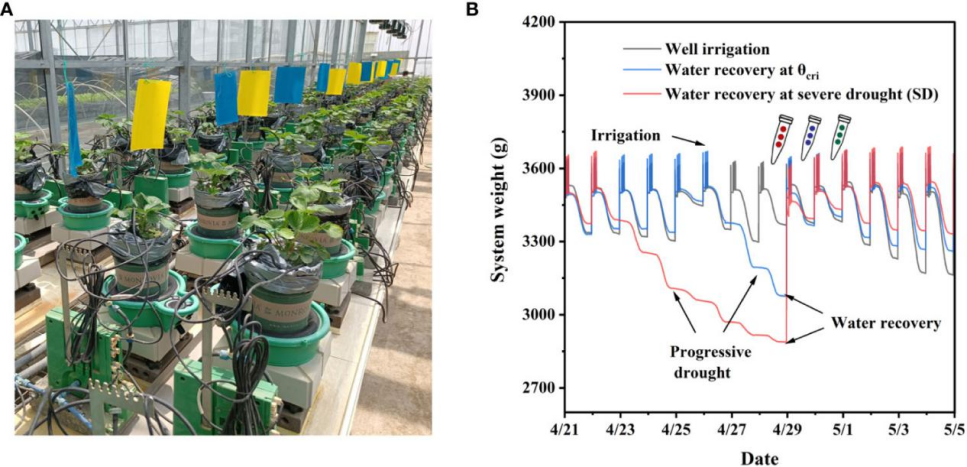品质至上,客户至上,您的满意就是我们的目标
当前位置: 首页 > 新闻动态
科学家利用Plantrarray系统发表园艺领域草莓功能生理表型研究文章
发表时间: 点击:614
来源:北京博普特科技有限公司
分享:
科学家最近利用Plantrarray功能生理表型系统发表了题为“Functional physiological phenotyping and transcriptome analysis provide new insight into strawberry growth and water consumption“的文章,文章发表于期刊Frontiers in Plant Science,在园艺种质资源、育种和表型研究领域,科学家利用该系统发表了多篇文章,涵盖果树、番茄、辣椒、草莓等等。

功能生理表型和转录组分析为草莓生长和耗水量研究提供了新视野
预计全球变暖将加剧农业用水短缺,因此,优化灌溉计划对于可持续的作物生产重要且及时的。有人提出了非充分灌溉,以平衡作物生长和用水,但临界阈值不容易量化。在这里,我们在高通量生理表型系统“Plantrarray”上对经历各种水分回收处理后的渐进干旱的草莓植物进行了实验。根据蒸腾速率(Tr)-体积土壤含水量(VWC)曲线的拐点,通过分段函数拟合,计算出植物蒸腾作用显著降低的临界土壤含水量。比较了水分充足植物(CK)、在进行性干旱后θcri点进行复水处理的植物(WR_θcri)和在进行性干燥后严重干旱时进行复水(WR_SD)处理的植物之间的水分关系的生理特征。结果表明,在整个试验过程中,WR_θcri处理下的植物中午Tr、日蒸腾量(E)和生物量增益与CK相当,但在水分胁迫阶段,WR_SD处理下的植株显著低于CK,即使再复水灌溉也无法恢复。为了探索基因调控机制,对三种处理中水回收前12小时、水回收后12小时和水回收后36小时收集的样本进行了转录组分析。对差异表达基因的GO和KEGG富集分析表明,在WR_θcri处理下,参与矿物质吸收和类黄酮生物合成的基因是最显著的转录可逆基因之一。功能生理表型和转录组数据为草莓灌溉和其他农业作物的潜在、定量和平衡节水策略提供了新的视野。
Functional physiological phenotyping and transcriptome analysis provide new insight into strawberry growth and water consumption
Global warming is expected to increase agricultural water scarcity; thus, optimized irrigation schedules are important and timely for sustainable crop production. Deficit irrigation, which balances crop growth and water consumption, has been proposed, but the critical threshold is not easily quantified. Here, we conducted experiments on strawberry plants subjecting progressive drought following various water recovery treatments on the high-throughput physiological phenotyping system “Plantarray”. The critical soil water contents (θcri), below which the plant transpiration significantly decreased, were calculated from the inflection point of the transpiration rate (Tr) - volumetric soil water content (VWC) curve fitted by a piecewise function. The physiological traits of water relations were compared between the well-watered plants (CK), plants subjecting the treatment of rewatering at the point of θcri following progressive drought (WR_θcri), and the plants subjecting the treatment of rewatering at severe drought following progressive drought (WR_SD). The results showed that midday Tr, daily transpiration (E), and biomass gain of the plants under WR_θcri treatment were equivalent to CK during the whole course of the experiment, but those under WR_SD treatment were significantly lower than CK during the water stress phase that could not recover even after rehydration. To explore the gene regulatory mechanisms, transcriptome analysis of the samples collected 12 h before, 12 h post and 36 h post water recovery in the three treatments was conducted. GO and KEGG enrichment analyses for the differentially expressed genes indicated that genes involved in mineral absorption and flavonoid biosynthesis were among the most striking transcriptionally reversible genes under the WR_θcri treatment. Functional physiological phenotyping and transcriptome data provide new insight into a potential, quantitative, and balanceable water-saving strategy for strawberry irrigation and other agricultural crops.